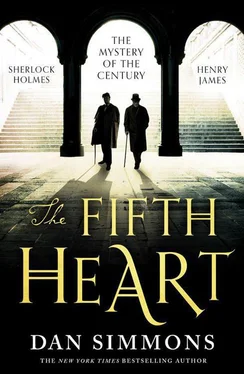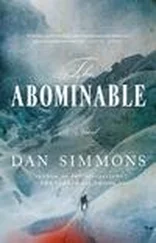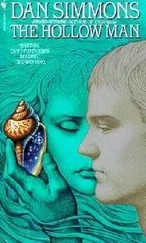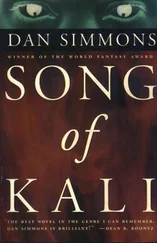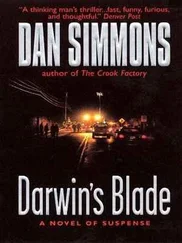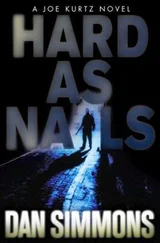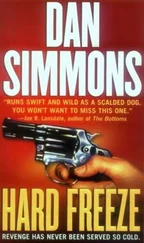“Incredible,” whispered John Hay.
“Yes, isn’t it,” agreed Holmes.
“How do we know that those supposed scars aren’t just more make-up?” demanded Clarence King.
Holmes had buttoned up his waistcoat and was in the act of sliding on his jacket when he paused. “Would you like to set your fingers into the wounds?” he asked softly. “You can, especially in the surgical incisions. Almost up to the knuckle of your index finger. Here, I shall remove my shirt again . . .”
“No!” cried King, waving for Holmes to stop the unbuttoning.
“So you are saying that Colonel Sebastian Moran did wait through the winter and tried to assassinate you as you came down out of Tibet in the spring of eighteen ninety-two,” said Hay.
“Not at all,” said Holmes, shooting his cuffs. “This man is the one who shot me three times from so far away. He’s perhaps the only marksman in the world who could have pulled off that shot and he’s long since displaced Colonel Sebastian Moran as the world’s deadliest assassin.” He’d set the second photograph in his outside jacket pocket, but now he handed it to be circulated in their small circle.
When it came to James, he was surprised to see a blurred photo of a much younger man than Moran—very short hair in a widow’s peak, sharp cheekbones, ears close set to his head, eyes that appeared all black in the image.
“You’re looking at the only known photograph—taken on a busy Indian street by a British Secret Service agent in New Delhi who was murdered the day after he sent that photograph to his superiors in Whitehall—of Colonel Sebastian Moran’s son. It’s a poor image, but the only photograph police and intelligence services have of this young man. He was illegitimate of course—Colonel Moran left a brace of bastards in his wake across India, Africa, Europe, and England—but this child was sired to a young adventuress in Warsaw. Surprisingly, Moran took the boy from his mother at a young age and raised him himself, dragging the boy around the world with him and using the lad as a sort of gun-carrier and general assistant in his Asian and other long hunting expeditions and . . . I am sure . . . on more private missions of paid assassination. The boy learned quickly. His first name is Lucan. He has in recent years, as I said, replaced his father as the most accomplished assassin the modern world has had the misfortune to know, but, totally unlike his father, he never kills for money. Lucan kills for his fanatical political beliefs. In this case his goal and god is . . . Anarchy.
“In that sense, never assassinating his enemies for pay, he is as much unlike his father, Colonel Moran, as any man on earth could be. But they both ended up serving the same master in Sikkim along the border of Tibet . . . the international group of anarchists who first paid Colonel Moran to follow me to India in eighteen ninety-one and then dispatched Lucan early the following year after his father had failed.”
“Anarchists,” muttered Clarence King. “Now comes the conspiracy.”
“A very real conspiracy, I’m afraid,” said Holmes. “I was also skeptical about the international threat of anarchists when I came to America in September of eighteen eighty-one to investigate your President Garfield’s assassination—and, indeed, there was no direct conspiracy involved there. But I later became certain that Colonel Moran had been the assassin in the pay of the anarchist terrorists at Chicago’s so-called Haymarket Square riots in eighteen eighty-six. The rifle shots that killed three of the four dead civilians and four of the seven dead policemen were fired, I proved to the American police and authorities beyond any doubt, from a rooftop half a block from the square. Colonel Moran and one henchman, not Lucan, used the same modern Lebel rifles that the colonel left behind in his attempt to assassinate Her Majesty in London the following year.”
“I’ve never read any of this anywhere,” said Hay.
“And you shan’t,” said Holmes. “At least until the Anarchist threat against England, Europe, and the United States is dealt with.”
“It seems a rather haphazard and random threat, Mr. Holmes,” said Hay.
James thought, Does John now believe that this is Sherlock Holmes with whom we’re dealing?
“Not haphazard or random at all, in their scheming,” said Holmes. “They have a list of presidents and royalty whom they plan to assassinate. In eighteen eighty-seven, as I said, they hired Moran to assassinate Her Majesty, Queen Victoria, at her own Golden Jubilee. Moran came far too close to succeeding. He did leave his new Lebel rifles—the first to use smokeless ammunition—behind in London, and using certain techniques I’ve refined over the years, I was able to ascertain that it was one of the same rifles used at Haymarket Square.
“The anarchists’ list remains. They currently plan to have your President Cleveland assassinated on May first, Opening Day of the World’s Columbian Exposition in Chicago. I need to stay here in America long enough to stop that.”
“Moran . . . senior or junior?” asked King.
“What?” said Holmes.
“You said that Moran had tried to kill Queen Victoria six years ago,” said King. “Colonel Moran, senior, or young Lucan Moran?”
“Oh, the only ‘Moran’ we’re dealing with is Colonel Moran . . . the father,” said Holmes. “He never gave his son Lucan his name.”
“May I see that second photograph again?” asked John Hay.
Holmes, who’d received it from King after it had gone around the circle of three men, carried it over and set it on the leather desktop in front of Hay.
“I know this man,” whispered Hay. “He was Rebecca Lorne’s . . . Clover Adams’s good friend Rebecca Lorne’s . . . young cousin, Clifton Richards. Also a photographer. Clover enjoyed talking to the young man about their shared art.”
“He bought her the new developing chemicals she used,” said Holmes, not asking a question. “Including the potassium cyanide solution.”
“Yes . . . yes . . . I believe you are correct,” said Hay in a pinched voice.
“I am,” said Holmes. He removed a third image from his jacket pocket and set it on the desk in front of Hay. James and King both stood and moved to Hay’s side to peer down at the photo.
It was obviously a professionally taken photograph, the kind done up for celebrities, and the woman was as beautifully dressed and attractive as any celebrity in any photograph James had ever seen—her dark hair raised in an artful sculpture, her large, dark eyes dancing with subtle lighting, her full lips at the level of her beautiful hands that were raised to grasp the handle of the parasol that shaded her.
“Why, that’s Rebecca Lorne, Clover’s good friend during the last year of her life,” said Hay. “She’s younger here than when I knew her in the months before Clover’s death, but I’m certain it’s the same woman. Very attractive.”
“Yes,” said King. “I also met her then . . . this Rebecca. I remember that Clover first saw her from her window at the Adamses’ former house, the house where Clover died, the Little White House at sixteen-oh-seven H Street just down the block. Clover saw her walking alone in Lafayette Square daily for some weeks before she finally went down to introduce herself. After that they were fast friends, even during Clover’s long period of melancholy.”
“And, strangely,” said Sherlock Holmes, “Mrs. Adams’s melancholy only grew worse despite the best efforts of her new friend Miss Lorne—and her young cousin Clifton—to cheer her up.”
Henry James had never seen this woman before, but then, he’d only heard about the delightful Rebecca Lorne in letters.
Читать дальше
